Construction Efficiency: Tips and Best Practices for Modern Projects
The construction industry faces a persistent challenge: projects consistently run over budget and behind schedule. According to McKinsey Global Institute research, large construction projects typically take 20% longer than scheduled and run 80% over budget. This isn't just about numbers on a spreadsheet – it's about real teams facing real pressures, trying to coordinate complex workflows while managing countless moving parts.
But here's the good news: construction efficiency isn't some mythical goal that only elite firms achieve. It's a systematic approach that any project team can implement with the right strategies, tools, and mindset. This guide reveals practical methods that transform chaotic job sites into models of predictable, profitable performance.

What is Construction Efficiency?
Construction efficiency measures how effectively a project team converts inputs – labor, materials, equipment, and time – into completed work. It's not simply about working faster; it's about working smarter through systematic optimization that eliminates waste and creates predictable outcomes.
Definition: Construction efficiency is the systematic optimization of resources, workflows, and coordination to maximize project value while minimizing waste, delays, and cost overruns.
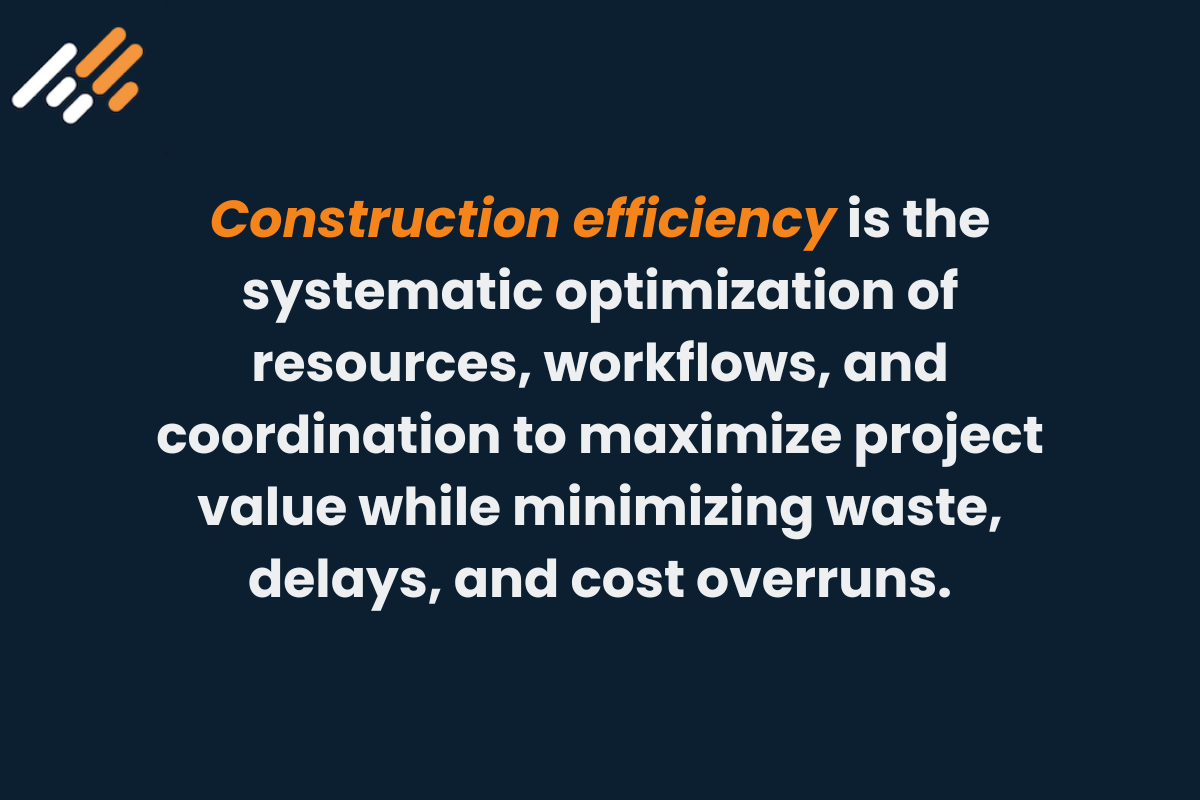
The most efficient construction projects share common characteristics: clear communication channels, coordinated trade sequences, predictable work rhythms, and real-time visibility into progress and potential problems. Understanding why these characteristics matter requires examining the broader impact of efficiency on project outcomes.
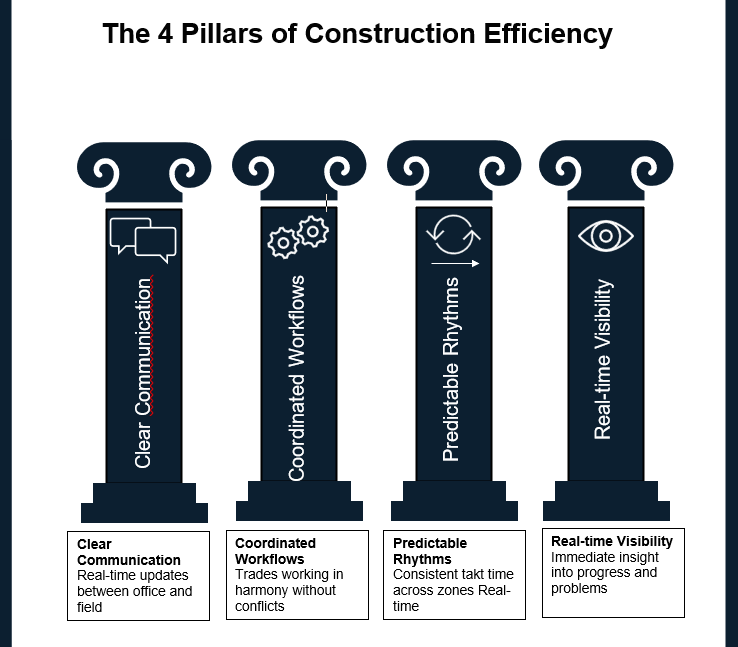
Why Efficiency Matters in Construction Projects
The construction industry operates on notoriously thin profit margins, typically ranging from 3-7%. In this environment, every percentage point of efficiency improvement directly impacts profitability and competitive positioning.
Reducing Waste: The National Institute of Standards and Technology reports that construction projects waste 10-30% of materials due to over-ordering, damage, theft, and poor planning. Efficient operations reduce this waste to 5% or less through systematic material management.
Cutting Costs: Labour represents 40-50% of total project costs. When crews experience downtime waiting for materials, equipment, or preceding trades, those costs continue accumulating without corresponding progress. Efficient scheduling and coordination minimize these non-productive periods.
Improving Productivity: Research from the Construction Industry Institute demonstrates that projects implementing systematic efficiency improvements achieve 15-25% better schedule performance compared to traditional management approaches.
With these compelling reasons to prioritize efficiency established, let's examine the specific factors that either enable or hinder efficiency in construction operations.
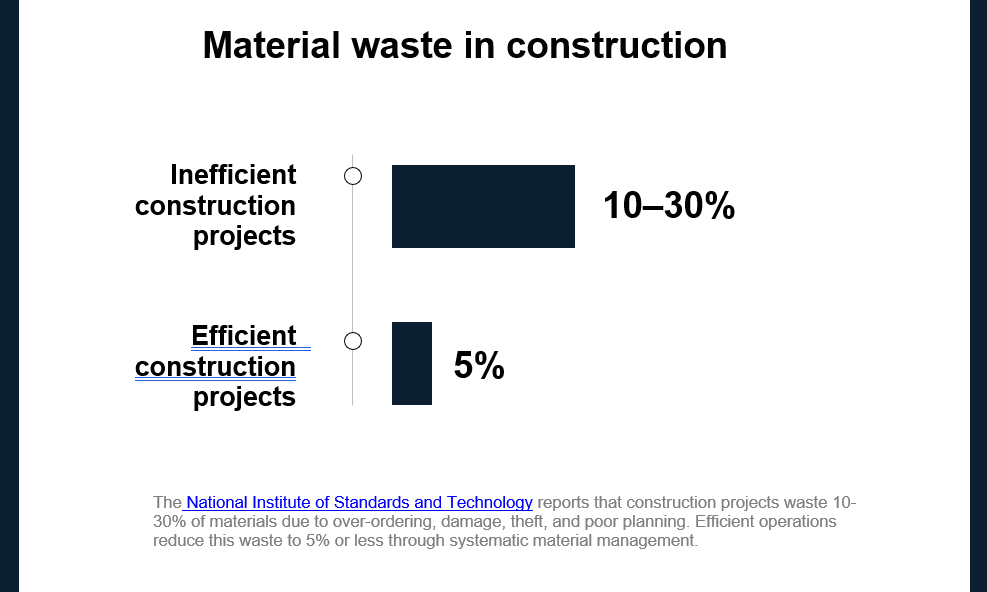
Key Factors Affecting Efficiency in Construction
Three primary factors determine whether construction projects achieve optimal efficiency: technology adoption, material management practices, and planning methodology.
Technology and Automation
Digital transformation has revolutionized how successful construction projects operate. Building Information Modeling (BIM) enables teams to identify conflicts before construction begins, preventing costly field changes. When integrated with scheduling platforms, BIM data creates powerful visualization tools that show exactly where and when work will occur.
Location-based scheduling technology represents a significant advancement over traditional Gantt chart methods. Unlike conventional tools that only display temporal relationships, location-based systems visualize spatial constraints and trade interactions – enabling teams to coordinate multiple trades without conflicts.
Tactplan Schedule implements this location-based approach by showing both when and where work happens across construction zones. The platform's visual interface immediately reveals potential conflicts between trades, enabling proactive resolution before problems impact the field.
Supply Chain and Material Management
Beyond technology, material logistics significantly impact efficiency. Material-related delays account for substantial construction inefficiency. Projects experience delays when materials arrive too early (creating storage problems), too late (causing crew downtime), or in incorrect quantities (requiring emergency reorders).
Effective material management requires coordinating procurement schedules with construction sequences, ensuring materials arrive just-in-time for installation. Digital tracking systems enable real-time visibility into material locations, delivery schedules, and consumption rates.
Project Planning and Scheduling
While technology and materials management provide important foundations, planning methodology ultimately determines coordination success. Traditional Critical Path Method (CPM) scheduling focuses exclusively on temporal relationships between activities, often failing to account for spatial constraints that drive real-world project performance.
Modern construction projects involve dozens of specialized trades working in overlapping sequences across limited workspace. Location-based scheduling addresses this by explicitly modeling where work occurs, not just when. This approach enables realistic coordination between trades, ensuring each team has dedicated workspace and appropriate timing.
Understanding these factors sets the stage for implementing specific operational strategies that maximize efficiency.
Operational Efficiency Strategies
Translating efficiency principles into practice requires specific operational strategies. Two approaches deliver particularly strong results: lean workflow optimization and real-time progress tracking.
Streamlining Workflows with Lean Principles
Lean construction principles provide powerful frameworks for eliminating waste. The core concept identifies seven types of waste: defects, overproduction, waiting, non-utilized talent, transportation, inventory, and motion.
Takt time planning represents an advanced workflow optimization approach that creates predictable work rhythms across construction zones. The takt time formula, adapted from Little's Law to construction, is:
Project Duration = (Tasks + Takt Zones - 1) × Takt Time
Consider a project with 20 units requiring 10 tasks each in a 3-month duration:
- Initial calculation: Takt Time = 12 weeks / (10 + 20 - 1) = 0.41 weeks or roughly 2 days
- By doubling resources: Project Duration = (10 + 20 - 1) × 1 day = 29 working days (under 1.5 months)
- By splitting zones in half: Project Duration = (10 + 40 - 1) × 1 day = 49 working days (~2.5 months)
The zone-splitting approach achieves 18% time savings without adding resources – demonstrating how smart planning improves efficiency.
Real-Time Progress Tracking
Lean planning creates optimal workflows, but maintaining that efficiency requires continuous monitoring through real-time progress tracking. Construction projects generate enormous amounts of data. The most efficient projects systematically collect and analyze this information to identify trends, predict problems, and continuously improve performance.
Tactplan Control provides mobile-first progress tracking that connects field teams directly to project schedules. Site supervisors update progress, report issues, and upload photos in real-time, ensuring project information remains current. This immediate connectivity enables faster response to changing conditions.
The integration between Tactplan Schedule and Control creates a powerful feedback loop where actual progress informs schedule adjustments, while updated schedules guide future work planning.
These operational strategies form the foundation for broader efficiency improvements across your organization.
Proven Strategies for Improving Construction Efficiency
Beyond operational tactics, three strategic initiatives deliver sustained efficiency improvements: digital tool implementation, workforce development, and enhanced collaboration.
Implement Digital Construction Management Tools
Modern construction management platforms integrate scheduling, progress tracking, and communication functions into unified systems. These tools eliminate information silos, where scheduling data lives in one system, cost information in another, and field updates in spreadsheets.
Location-based scheduling platforms enable project teams to visualize work across both time and space dimensions. This visualization reveals coordination challenges that remain hidden in traditional Gantt charts, enabling proactive problem-solving.
Invest in Workforce Training
However, technology alone doesn't create efficiency – people do. Training programs should address both technical skills and collaborative practices. The most effective programs combine formal instruction with on-the-job coaching and mentoring.
Enhance Communication and Collaboration
Trained teams perform best when supported by robust communication systems. Construction projects involve numerous stakeholders with different information needs. Daily briefings with trade foremen create alignment around immediate priorities. Weekly coordination meetings with subcontractors address upcoming work and potential schedule adjustments.
Digital communication platforms enable instant updates and reduce delays inherent in email-based communication. When field supervisors can immediately report problems and receive guidance, response times decrease dramatically.
When implemented systematically, these strategies deliver measurable benefits across multiple project dimensions.
Benefits of Improved Construction Efficiency
Efficiency investments yield concrete returns. Organizations implementing systematic efficiency programs typically realize benefits in three key areas: cost reduction, schedule acceleration, and quality improvement.
Traditional Gantt Chart Scheduling: In the below image you see how complex Gantt charts have overlapping tasks and no spatial context:
- No location visibility
- Hidden conflicts between trades
- Difficult to communicate to field teams
- Reactive problem-solving
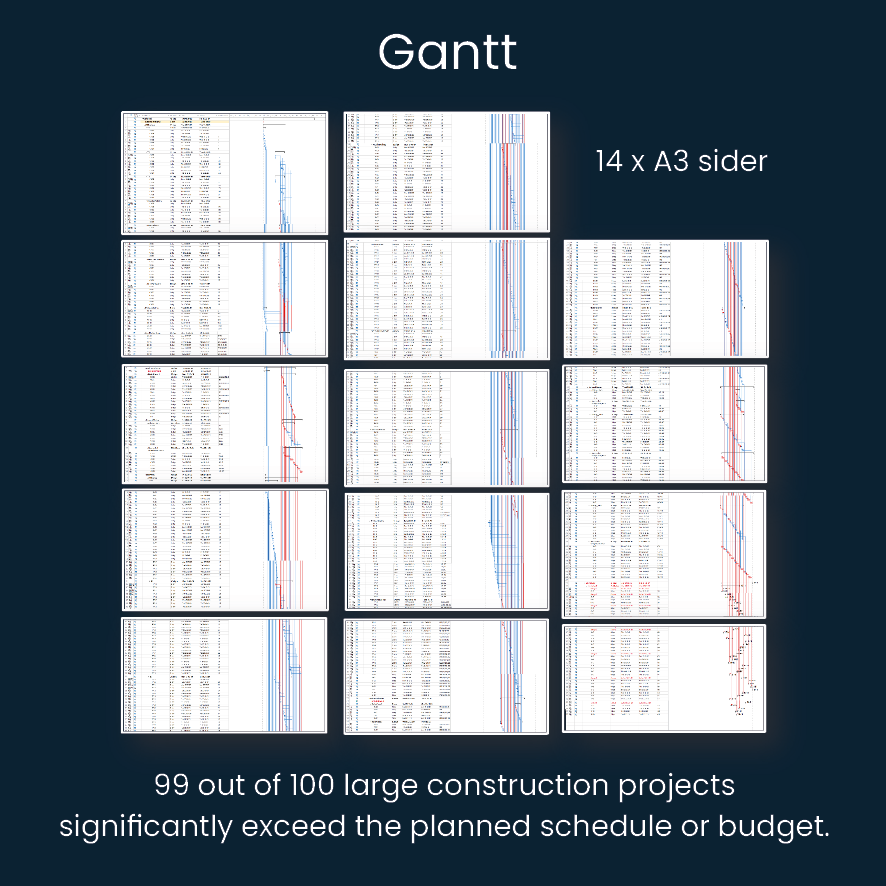
Comparing that with Location-Based Scheduling (Like Tactplan) you will see in below image showing a visual flowline schedule across building zones:
- Clear spatial-temporal view
- Conflicts visible immediately
- Intuitive for all stakeholders
- Proactive coordination
Perhaps one the the most important benefits of location-based scheduling over traditional Gantt charts is that where Gantt charts takes up 14 A3 printed pages or more, the same construction project with the same level of detail will only take up one printed A3 page when created in Tactplan.
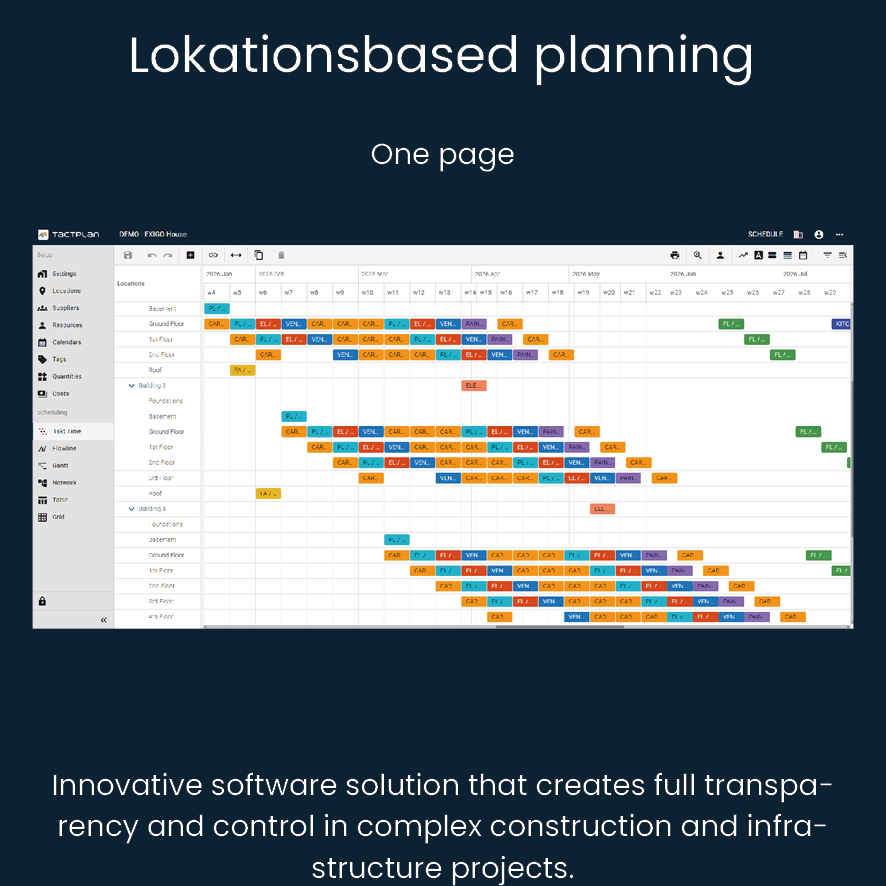
Cost Savings and Better Profit Margins
Direct cost savings from efficiency improvements typically range from 10-20%. These savings come from reduced labor costs, lower material waste, decreased equipment expenses, and minimized rework.
Beyond direct savings, efficiency improvements expand profit margins by enabling firms to complete more projects with existing resources. A 15% reduction in project duration effectively increases organizational capacity by 15%.
Faster Project Completion
Cost savings matter, but schedule reliability often determines competitive success. Schedule reliability directly impacts client satisfaction and repeat business opportunities. Contractors with strong schedule performance records command premium pricing and win higher percentages of competitive bids.
Enhanced Quality and Safety
Beyond financial metrics, efficiency improvements create safer, higher-quality outcomes. Efficiency and quality are complementary objectives. When trades have adequate time and space to perform work without rushing, quality naturally improves. According to OSHA research, congested work areas and schedule pressure contribute significantly to construction accidents.
These benefits aren't theoretical – leading contractors are achieving them today.
Real-World Success: Birch Properties Case Study
Danish developer Birch Properties implemented location-based portfolio management across multiple residential projects, demonstrating how these efficiency principles translate into practice.
.png)
Helle Kvartborg, Team Leader for Scheduling & Portfolio Management with Birch Properties states: "By working with a Lean Construction approach, location-based project management regarding both time and economics is the only right way to achieve optimal flow and real overview." Thus the results achieved are really valuable:
- Immediate delay detection
- Reduced buffer costs in subcontractor bids
- 2-year advance resource planning visibility
- Stronger contractor partnerships
Helle Kvartborg continues by adding: "By working with a Lean Construction approach, location-based project management regarding both time and economics is the only right way to achieve optimal flow and real overview."
The results were impressive. As Kvartborg explains: "Because we use location-based stage registration, we would discover the carpenter's delay immediately, not first when the delay has consequences for the subsequent electrician and painter."
The financial benefits extended beyond direct cost savings. Birch Properties developed long-term partnerships with subcontractors based on detailed resource planning visibility: "We could in principle tell [a contractor] that in August 2025, two of his men will be on the 2nd floor in stairwell 4 in a newly built residential building in Aarhus."
While Birch Properties' success is impressive, implementing efficiency improvements isn't without challenges.
Overcoming Common Efficiency Challenges
Three obstacles commonly hinder efficiency initiatives. Understanding and addressing these challenges increases implementation success.
Resistance to Change
Construction culture often resists new methods. Overcome this resistance by demonstrating value through pilot projects and involving field personnel in solution development. Start small with focused improvements, document results carefully, and expand successful approaches.
Data Quality Issues
Even when teams embrace change, data collection challenges can undermine digital initiatives. Construction sites present challenging data collection environments. Address these challenges through simplified interfaces designed for field conditions, ruggedized devices, and backup processes that ensure critical information gets captured.
System Integration
Finally, technical integration challenges can slow adoption. Construction firms typically use multiple software systems. Prioritize integration points that deliver maximum value. The connection between scheduling and progress tracking typically provides immediate benefits by ensuring plans reflect field realities.
Successfully navigating these challenges positions your organization to capture the full value of efficiency improvements.
.png)
Transform Your Construction Efficiency Today
Construction efficiency represents a systematic approach that any project team can implement to improve performance and profitability. The evidence is clear: organizations that prioritize location-based scheduling, lean workflows, and real-time tracking consistently outperform competitors using traditional methods.
Digital tools like Tactplan Schedule and Control translate methodological improvements into practical solutions. By combining visual planning with real-time progress tracking, these platforms create the feedback loops necessary for continuous improvement.
The efficiency improvements documented in this guide – 10-20% shorter construction times and 15-25% better schedule performance – represent achievable targets for projects implementing systematic efficiency strategies.
Ready to transform your construction efficiency? Contact Tactplan today to schedule a personalized demo showing how location-based scheduling and real-time progress tracking can revolutionize your project delivery.




